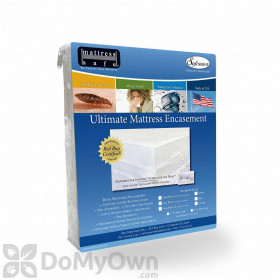
Like most parasites, bed bugs prefer to live near their next meal-you. However, many people are not comfortable having chemical pesticides sprayed in the places that they sleep and lounge, including mattresses, bedding, sofas, and recliners. Luckily there are many non-chemical methods that have been scientifically proven effective in bed bug control in these sensitive areas. These methods, in conjunction with the proper use of chemical pesticides in less-sensitive areas of the infested home or building, can aid you in achieving full control.
Methods of Pesticide-Free Bed Bug Control
Disposal
Encasement
If an old infested bed is to be kept, your best non-chemical method of control is to place a smooth, tight-fitting, hardy cover over your old mattress. This is known as encasement. Encasing the mattress and box springs prevents an infestation from growing by denying bed bugs access to the hard-to-treat inner areas. You will easily be able to spot and remove new clusters of bed bugs on the smooth cover, and bed bugs that happen to be inside the cover become entombed and will eventually die.
Products needed for Method 2
Vacuum
Using a vacuum to target infested bed bug harborages can be useful if it is done properly. Keep in mind that while vacuuming may reduce surface populations, it will not reach bed bugs located in deep crevices.
- Because bed bugs and their eggs cling tightly to surfaces, it is best to scrape the end of the vacuum repeatedly over the target area.
- Do not use a brush attachment, as some bed bugs and eggs will remain alive in the bristles and be transferred to other areas of the home.
- After vacuuming, the vacuum bag should be removed, sealed tightly in a garbage bag, and discarded immediately to control for bed bugs and eggs that may have survived the ride down the suction hose.
Steamer
Temperatures of 120 degrees F are lethal to bed bugs (as well as most other insects), and the use of a steamer at kills both bed bugs and eggs on contact. The best steamer to use for bed bugs is one that emits very little moisture and has a large brush head.
- Steam vapors should be too hot to touch to be effective. A towel wrapped around the brush head will intensify hot vapors which can be checked with a digital infrared thermometer.
- The steamer head should be directly over the surface being treated.
- Finished wood surfaces or other items that might be damaged by high heat should not be treated with the steaming technique.
Washer & Dryer
When bed bugs manage to infest personal items such as bedding and clothing that cannot be treated with pesticides, a great non-chemical treatment is to wash and dry the items on the hottest possible setting. The typical dryer will reach up to 180 degrees F ten minutes into its cycle, a temperature that is lethal to bed bugs and their eggs. Other items that can be treated in the washer and dryer, or just the dryer alone include soft toys, rugs, backpacks, and footwear.
Seasonal Temperatures
- High Seasonal Temps: Wrapping infested items in plastic and placing them outside on the pavement in direct sunlight will de-infest mattresses, furniture, and other belongings. A thermometer should be used to monitor temperatures inside the plastic. The temperature must be at least 120 degrees F inside the bag for this method to be effective.
- Low Seasonal Temps: In colder locations, freezing may also be a non-chemical way to de-infest belongings. This method is more difficult to utilize since freezing bed bugs requires that they remain for two weeks at temperatures below 0 degrees F. In most cases and locations, heating is a more realistic option.
Steri-Fab / Bedlam
Steri-Fab and Bedlam are disinfectant/pesticide products made from environmentally safe pyrethrins. While both are technically pesticides, they have a comparatively short residual and have been proven safe for use on human contact surfaces such as beds and upholstered furniture. In lab tests, Steri-Fab and Bedlam killed 100% of bed bugs and eggs when sprayed on clusters directly. When new eggs hatched on surfaces treated with either chemical up to 7 days earlier, 85% to 98% were killed.







/FurnitureSafe_(2).jpg.thumb_280x280.jpg)


